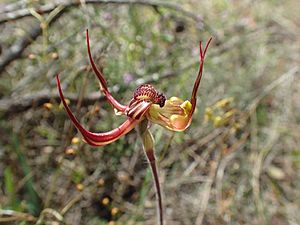Lazy spider orchid facts for kids
Quick facts for kids Lazy spider orchid |
|
|---|---|
 |
|
| Caladenia multiclavia growing near Jerramungup | |
| Scientific classification | |
| Genus: |
Caladenia
|
| Species: |
multiclavia
|
| Synonyms | |
|
|
The Caladenia multiclavia, also known as the lazy spider orchid, is a special type of orchid. It grows only in the south-west part of Western Australia. This means it is endemic to that area.
This orchid has a single leaf that feels hairy. It usually grows one or two flowers. These flowers are greenish-yellow, red, and cream-coloured. They look a bit like a spider resting or "reclining." Even though one plant often has only one flower, you can often find groups of up to six plants growing together.
Contents
What Does the Lazy Spider Orchid Look Like?
The lazy spider orchid is a plant that grows from the ground. It is a perennial plant, meaning it lives for more than two years. It is also a deciduous herb, which means it loses its leaves at certain times. This orchid grows from an underground tuber, which is like a swollen stem that stores food.
Leaves and Stems
Each plant has one straight, hairy leaf. This leaf is usually about 4 to 10 centimetres (1.6 to 3.9 inches) long. It is also about 0.5 to 1 centimetre (0.2 to 0.4 inches) wide. The flowers grow on a stalk that stands tall. This stalk can be about 10 to 25 centimetres (3.9 to 9.8 inches) high.
Flowers
The lazy spider orchid can have up to three flowers on its stalk. Each flower is about 3 to 4 centimetres (1.2 to 1.6 inches) long and wide. The flowers are a mix of greenish-yellow, red, and cream colours. They are shaped like a spider that is lying down.
The flowers have parts called sepals and petals. These parts have thin, thread-like tips.
- The dorsal sepal (the one at the back) and the petals are close together. They curve down behind the column (a central part of the flower) near their bases. Then, they sweep upwards at the back of the flower.
- The lateral sepals (the ones at the front) are arranged in a similar way.
The dorsal sepal is about 3 to 4 centimetres (1.2 to 1.6 inches) long and 0.3 to 0.4 centimetres (0.1 to 0.2 inches) wide. The lateral sepals are about 3 to 4 centimetres (1.2 to 1.6 inches) long and 0.4 to 0.5 centimetres (0.2 to 0.2 inches) wide. The petals are about 2.5 to 3.5 centimetres (1.0 to 1.4 inches) long and about 0.3 centimetres (0.1 inches) wide.
The Labellum
The labellum is a special lip-like part of the orchid flower. For the lazy spider orchid, the labellum is about 1.4 to 1.6 centimetres (0.6 to 0.6 inches) long and wide. It is shaped like a diamond. The centre of the labellum has clear red stripes.
In the middle of the labellum, there is a thick group of reddish, club-shaped parts. These are called calli. They can be up to 0.25 centimetres (0.1 inches) long. The lazy spider orchid usually flowers from September to October.
How the Lazy Spider Orchid Got Its Name
The lazy spider orchid was first officially described in 1871. This was done by a scientist named Heinrich Reichenbach. His description was published in a book called Beitrage zur Systematischen Pflanzenkunde.
The second part of its scientific name, multiclavia, comes from two Latin words:
- multus, which means "much" or "many".
- clava, which means "club".
This name refers to the many club-shaped calli found on the labellum of this orchid.
Where Does the Lazy Spider Orchid Live?
The lazy spider orchid grows in a specific area of Western Australia. You can find it in a band between Wongan Hills and Ravensthorpe. This area includes different natural regions like the Avon Wheatbelt, Esperance Plains, and Mallee.
It likes to grow in places with she-oak thickets. These are dense groups of she-oak trees. It also grows in open woodlands, which are forests with trees that are not too close together.
Is the Lazy Spider Orchid Protected?
The Western Australian Government's Department of Parks and Wildlife has looked at the lazy spider orchid. They have classified it as "not threatened." This means that, for now, there are enough of these orchids, and they are not in danger of disappearing.
See also
 In Spanish: Caladenia multiclavia para niños
In Spanish: Caladenia multiclavia para niños


